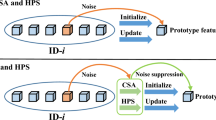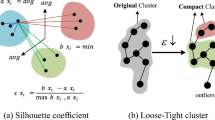Abstract
Person reidentification (re-ID) is an important topic in computer vision. This paper studies an unsupervised approach to re-ID, which does not require any labeled information and is thus possible to deploy in real-world scenarios. State-of-the-art unsupervised re-ID methods usually use a memory bank to store the instance feature vectors, generate pseudolabels with a clustering algorithm, and compare the query instances to the centroid of the clusters for contrastive learning. However, because hard negative or noisy samples exist, the centroid generated by unsupervised learning may not be a perfect prototype. Forcing the wrong images to get closer to the centroid would result in accumulated errors and deteriorated overfitting. To solve this problem, we propose a quantitative random selection strategy to form the cluster feature representation. Specifically, in each iteration, the cluster algorithm executes on instance-level feature vectors to generate pseudolabels. Then, we shuffle all the instance vectors belonging to the same cluster and select samples within the same cluster in a certain proportion to form the cluster-level memory. During network training, the query instances are used to update the cluster-level memory for contrastive learning. Extensive experiments show that our proposed method produces state-of-the-art performance in unsupervised person re-ID tasks.


Similar content being viewed by others
References
Sun Y, Zheng L, Yang Y, Tian Q, Wang S (2018) Beyond part models: Person retrieval with refined part pooling. In: Proceedings of the European conference on computer vision
Su C, Li J, Zhang S, Xing J, Gao W, Tian Q (2017) Pose-driven deep convolutional model for person re-identification. In: ICCV
Tian H, Zhang X, Lan L, Luo Z (2019) Person re-identification via adaptive verification loss. Neurocomputing 359:93–101
Fan H, Zheng L, Yan C, Yang Y (2018) Unsupervised person re-identification Clustering and finetuning. ACM Trans Multimed Comput Commun Appl 14(4):1–18
Lin Y, Dong X, Zheng L, Yan Y, Yang Y (2019) A bottom-up clustering approach to unsupervised person re-identification. In: Proceedings of the AAAI Conference on Artificial Intelligence, vol 33, pp 8738–8745
Ester M, Kriegel H-P, Sander J, Xu X et al (1996) A density-based algorithm for discovering clusters in large spatial databases with noise. In: ACM SIGKDD Conference on Knowledge Discovery and Data Mining, vol 96, pp 226–231
MacQueen J et al (1967) Some methods for classification and analysis of multivariate observations. In: Proceedings of the fifth Berkeley symposium on mathematical statistics and probability, vol 1, pp 281–297
Liu X, Zhu X, Li M et al (2017) Multiple Kernel k-means with Incomplete Kernels. In: AAAI, pp 1–1
Yu X, Ye X, Gao Q (2019) Pipeline image segmentation algorithm and heat loss calculation based on gene-regulated apoptosis mechanism. In: International Journal of Pressure Vessels and Piping, vol 172
Yu X, Lu YH, Gao Q (2021) Pipeline image diagnosis algorithm based on neural immune ensemble learning. Int J Press Vessel Pip 104249:189
Ristani E, Solera F, Zou R, Cucchiara R, Tomasi C (2016) Performance measures and a data set for multi-target, multi-camera tracking. In: ECCV, pp 17–35
Zheng L, Shen L, Tian L, Wang S, Wang J, Tian Q (2015) Scalable person re-identification: A benchmark. In: ICCV, pp 1116–1124
Wu Z, Xiong Y, Yu SX, Lin D (2018) Unsupervised feature learning via non-parametric instance discrimination. In: Proceedings of the IEEE conference on computer vision and pattern recognition, pp 3733–3742
Zhai Y, Ye Q, Lu S, Jia M, Ji R, Tian Y (2020) Multiple expert brainstorming for domain adaptive person re-identification. In: Proceedings of the European conference on computer vision
Zou Y, Yang X, Yu Z, Kumar BVK, Kautz J (2020) Joint disentangling and adaptation for crossdomain person re-identification. In: Proceedings of the European conference on computer vision
Zheng K, Lan C, Zeng W, Zhang Z, Zha Z-J (2021) Exploiting sample uncertainty for domain adaptive person re-identification. In: AAAI, pp 3538–3546
Deng W, Zheng L, Ye Q, Kang G, Yang Y, Jiao J (2018) Image-image domain adaptation with preserved self-similarity and domain-dissimilarity for person re-identification. In: Proceedings of the IEEE Conference on Computer Vision and Pattern Recognition
Xuan S, Zhang S (2021) Intra-inter camera similarity for unsupervised person re-identification. In: CVPR, pp 11926–11935
Zhong Z, Zheng L, Luo Z, Li S, Yang Y (2019) Invariance matters: Exemplar memory for domain adaptive person re-identification. In: Proceedings of the IEEE conference on computer vision and pattern recognition, pp 598–607
Ge Y, Zhu F, Chen D, Zhao R, Li H (2020) Self-paced contrastive learning with hybrid memory for domain adaptive object re-id. In: Advances in neural information processing systems, vol 33, pp 11309–11321
Liu X, Zhang S (2021) Graph consistency based mean-teaching for unsupervised domain adaptive person re-identification. In: IJCAI, pp 874–880
He K, Zhang X, Ren S, Sun J (2016) Deep residual learning for image recognition. In: CVPR, pp 770–778
Dai Z, Wang G, Yuan W et al (2021) Cluster Contrast for Unsupervised Person Re-Identification, arXiv:2103.11568
He K, Fan H, Wu Y, Xie S, Girshick R (2020) Momentum contrast for unsupervised visual representation learning. In: CVPR, pp 9729–9738
Zheng K, Liu W, He L, Mei T, Luo J, Zha Z-J (2021) Group-aware label transfer for domain adaptive person re-identification. In: CVPR, pp 5310–5319
Zheng Y, Tang S, Teng G, Ge Y, Liu K, Qin J, Qi D, Chen D (2021) Online pseudo label generation by hierarchical cluster dynamics for adaptive person re-identification. In: ICCV, pp 8371–8381
Wu Y, Wu X, Li X, Tian J (2021) MGH:metadata guided hypergraph modeling for unsupervised person re-identification. In: ACM Multimedia, pp 1571–1580
Chen H, Lagadec B, Bremond F (2021) ICE: Inter-instance contrastive encoding for unsupervised person re-identification. arXiv:2103.16364
Zhang Z, Lan C, Zeng W, Jin X, Chen Z (2020) Relation-aware global attention for person re-identification. In: CVPR, pp 3186–3195
Zhong Z, Zheng L, Luo Z, Li S, Yang Y (2020) Learning to adapt invariance in memory for person re-identification. IEEE Transactions on Pattern Analysis and Machine Intelligence PP(99):1–1
Yu HX, Zheng WS, Wu A, Guo X, Lai JH (2019) Unsupervised person re-identification by soft multilabel learning. In: CVPR
Fu Y, Wei Y, Wang G, Zhou Y, Shi H, Huang TS (2019) Self-similarity grouping: A simple unsupervised cross domain adaptation approach for person re-identification. In: ICCV, pp 6112–6121
Wang Z, Zhang J, Zheng L, Liu Y, Sun Y, Li Y, Wang S (2020) Cycas: Self-supervised cycle association for learning re-identifiable descriptions. In: CycAs: Self-supervised Cycle Association for Learning Re-identifiable Descriptions
Zhai Y, Lu S, Ye Q, Shan X, Tian Y (2020) Ad-cluster: Augmented discriminative clustering for domain adaptive person re-identification. In: Proceedings of the IEEE conference on computer vision and pattern recognition
Li J, Zhang S (2020) Joint Visual and Temporal Consistency for Unsupervised Domain Adaptive Person Re-Identification
Zou Y, Yang X, Yu Z, Kumar B, Kautz J (2020) Joint disentangling and adaptation for cross-domain person re-identification. In: Proceedings of the European conference on computer vision
Ge Y, Chen D, Li H (2020) Mutual mean-teaching: Pseudo label refinery for unsupervised domain adaptation on person re-identification. In: International conference on learning representations
Chen G, Lu Y, Lu J, Zhou J (2020) Deep credible metric learning for unsupervised domain adaptation person re-identification. In: Proceedings of the European conference on computer vision, pp 643–659
Zhai Y, Ye Q, Lu S, Jia M, Ji R, Tian Y (2020) Multiple expert brainstorming for domain adaptive person re-identification. In: Proceedings of the European conference on computer vision
Lin Y, Dong X, Zheng L, Yan Y, Yang Y (2019) A bottom-up clustering approach to unsupervised person re-identification. In: Proceedings of the AAAI conference on artificial intelligence, vol 33, pp 8738–8745
Wu J, Yang Y, Liu H, Liao S, Lei Z, Li S (2019) Unsupervised graph association for person re-identification. In: ICCV, pp 8321–8330
Lin Y, Xie L, Wu Y, Yan C, Tian Q (2020) Unsupervised person re-identification via softened similarity learning. In: CVPR, pp 3390–3399
Wang D, Zhang S (2020) Unsupervised person re-identification via multi-label classification. In: CVPR
Zeng K, Ning M, Wang Y, Guo Y (2020) Hierarchical clustering with hard-batch triplet loss for person re-identification. In: CVPR, pp 657–665
Wang M, Lai B, Huang J, Gong X, Hua X-S (2021) Camera-aware proxies for unsupervised person re-identification. In: AAAI
Funding
This work is supported by the National Natural Science Foundation of China (Grant No. U1833115).
Author information
Authors and Affiliations
Corresponding author
Ethics declarations
Conflict of Interests
The authors declare that they have no conflicts of interest.
Additional information
Publisher’s note
Springer Nature remains neutral with regard to jurisdictional claims in published maps and institutional affiliations.
Rights and permissions
Springer Nature or its licensor holds exclusive rights to this article under a publishing agreement with the author(s) or other rightsholder(s); author self-archiving of the accepted manuscript version of this article is solely governed by the terms of such publishing agreement and applicable law.
About this article
Cite this article
Zhang, X., Feng, Z. Unsupervised person reidentification via quantitative random selection for cluster centroid. Appl Intell 53, 10726–10733 (2023). https://doi.org/10.1007/s10489-022-03439-x
Accepted:
Published:
Issue Date:
DOI: https://doi.org/10.1007/s10489-022-03439-x




